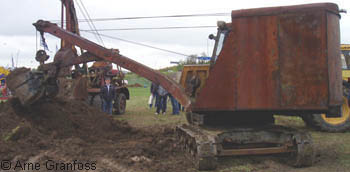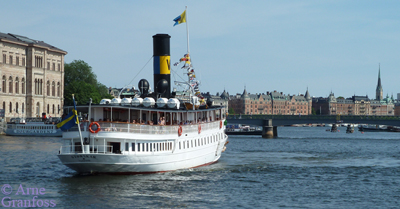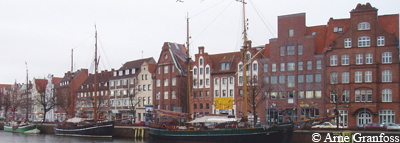Sweden as middleman

 UNDER CONSTRUCTION Version 0.31
UNDER CONSTRUCTION Version 0.31
|
Sweden in World War II - across borders
|
 |
![]()
![]()
The Soviet Union sent Finland a message on 29 January 1940, via Sweden, that they were willing to negotiate peace in the war that they had started. [s19]
![]()
![]()
At the end of April 1940 the Norwegian king and government was in Molde, at the coast to the Atlantic Ocean. A photographer was assigned by the Norwegian Foreign Office and the Norwegian Telegram Bureau (news agency) to find them, and among others take photos of the king and the crown prince on the run.
Among others he took a couple of photos of them standing beside a birch tree, while the bombs was falling on Molde. He then travelled with a fishing boat north to Bodø and over the mountains to Sweden. In Stockholm interviews and
photos were presented at a press conference in the Norwegian consulate. The Swedish weekly magazine Vecko-Journalen was first to publish the photos of the king and crown prince, later it was published in Life and became famous. [s11]
(The Norwegian prime ministers very negative experience of the British troops that were sent to the Molde and Åndalsnes area did not become that famous. Neither did the negative impression of British politics he got later. He mentions among others a converstaion between a Norwegian man and Winston Churchill, where Churchill said that the only way was to get a grip on Narvik and then fight southwards along the railway. When the Norwegian told that htere was only one railway from Narvik, and that led to Sweden, Churchill is said to have said rather indifferently: oh. [s11])
![]()
In early June 1940, before the Allied troops left Norway, there was an attempt to end the fighting in Norway. The Swedish foreign minister had discussed the plan with the Norwegian minister in Stockholm, and the Norwegians presented it to the British who accepted it after internal discussions.
The Norweian and Swedish foreign ministers finished a suggestion to Germany on 3 June. According to the plan the German troops should withdraw to the south of a demarcation line,
only Norwegian troops should remain in the free Norway north of the line, and Swedish troops should be positioned on both sides of the demarcation line.
The Germans waited with the answer, since they understood that the Allied troops would be withdrawn from Norway. [s10] (and [s11])
The idea originated from the Norwegian politician Mowinckel who was in Stockholm, and was not decided by the Norwegian government before it was presented to the Swedish foreign minister. [s01]
 The idea originated from a Swedish businessman and 'hobby diplomat' Dahlérus, who was a longtime friend with Göring and acted as an informal contact between Sweden and Germany. He discussed it for the first time a month after the German attack on Denmark and Norway. On the 4 May Göring invited him to Berlin, and Dahlérus met the Swedish foreing minister Günther for advice. Günther feared that the Germans would press for permission to transit troops through Sweden to Norway. Dahlérus also met the Norwegian consultative cabinet minister Mowinckel who worked in Stockholm, who asked Dahlérus to give the Germans the Norwegian arguments. Mowinckel had a fear for what would happen to the Norwegians in the area, and didn't understand why the Germans wanted to occupy northern Norway. Among others Göring suggested that they could send weapons and ammunitions among food and civilian equipment to the hard pressed German troops in Narvik, and that the Swedish customs learn to close their eyes for a period and only check some marked boxes in the transports. Sweden was most enthusiastic about the plan, since it was seen as a tool to keep Sweden free from German attack and ultimatums and also would give Sweden control over important Norwegain ports towards the west. [s51]
The idea originated from a Swedish businessman and 'hobby diplomat' Dahlérus, who was a longtime friend with Göring and acted as an informal contact between Sweden and Germany. He discussed it for the first time a month after the German attack on Denmark and Norway. On the 4 May Göring invited him to Berlin, and Dahlérus met the Swedish foreing minister Günther for advice. Günther feared that the Germans would press for permission to transit troops through Sweden to Norway. Dahlérus also met the Norwegian consultative cabinet minister Mowinckel who worked in Stockholm, who asked Dahlérus to give the Germans the Norwegian arguments. Mowinckel had a fear for what would happen to the Norwegians in the area, and didn't understand why the Germans wanted to occupy northern Norway. Among others Göring suggested that they could send weapons and ammunitions among food and civilian equipment to the hard pressed German troops in Narvik, and that the Swedish customs learn to close their eyes for a period and only check some marked boxes in the transports. Sweden was most enthusiastic about the plan, since it was seen as a tool to keep Sweden free from German attack and ultimatums and also would give Sweden control over important Norwegain ports towards the west. [s51]
When the Allies withdrew from Norway, the plan about a demarcation line between south and north Norway was awoken again. This time by the British, who saw positive effects like continued communication with Sweden and that there would not be any German military bases in norhtern Norway. On 3 June the Norwegian foreign minister flew to Luleå in Sweden for a meet with the Swedish foreign minister. A draft of an agreement is formulated, which Sweden shall present to Germany. A time limit was set, if Germany had not responded before 14.00 (2 PM) on 8 June Norway would take it as a no. On the afternoon of 7 June the Norwegian government and others left Norway to continue the fight from Britain, but the foreign minister stayed one more day in Norway. There was no answer from Germany, and the Swedish troops stayed in Sweden. [s51]
![]()
In early June 1940 it was decided that the families, who had fled to Sweden, to the Norwegian members of the government should be transported to Petsamo in northern Finland and on with ship to Tromsø where
the king and the government were. For one group the journey from Östersund in Sweden to Tromsø in Norway had taken close to four days and nights, with only a two hour stop. They left Norway for Britain on the British cruiser Devonshire on 7 June 1940. Before that, they had changed the law so that the Norwegian king and government could rule Norway even if they were on foreign soil. [s11])
![]()
Rumours in Norway in July 1940 may have been true, about a German peace feeler sent to Britain via Stockholm. On 19 July Hitler offered Britain peace. [s10]
R. A. B. Butler, deputy for Britain's foreign secretary, met Björn Prytz, Sweden's minister in London, on 17 June 1940 [s38]. Seemingly there were more meetings.
![]()
The Swedish king Gustaf V offered his bona officia to Britain and Germany in early August 1940 [s10]. (That meant that Sweden was willing to facilitate negotiations between for example Britain and Germany.)
![]()
![]()
On 25 June 1941 Sweden accepted to act as diplomatic "skyddsmakt" ('protective power') for the Soviet Union towards Germany. As such, Sweden foremost could act with humanitarian efforts for Soviet Union citizens. On 17 July 1941 Stalin offered, via Sweden, to begin to follow the Geneva convention. Hitler refused. [s53]
Sweden managed to use some special aid for Soviet Union citizens who had been interned in Germany on 22 June 1941. [s53]
![]()
![]()
![]()
At the end of January 1943 the U.S.A., seconded and supported by Sweden, contacted the Soviet Union about the possibilities for a separate peace between Finland and the Soviet Union. The Soviets first wanted to see Finlands proposal for peace terms, but Finland was only interested in a separate peace with Britain.
In late July 1943 the Soviet Union contacted the Belgian minister in Stockholm about a peace discussion between Finland and the Soviet Union. Finlands peace terms was not accepted by the Soviet Union. [s58]
 In November 1943 the Soviet Union used a tougher tone towards Finland, among others declaring that Finland was an axis power with Germany and should follow the Allied demand for unconditional surrender. Anyway the Soviet Union minister in Stockholm informed Finland later in November, via the Swedish government, that Finland was welcome to Moscow to enter peace negotiations. [s58]
In November 1943 the Soviet Union used a tougher tone towards Finland, among others declaring that Finland was an axis power with Germany and should follow the Allied demand for unconditional surrender. Anyway the Soviet Union minister in Stockholm informed Finland later in November, via the Swedish government, that Finland was welcome to Moscow to enter peace negotiations. [s58]
Contacts continued in and via Sweden in 1944, with information exchange and meetings. Stockholm was also used when Finnish representatives flew to Moscow for discussions. Swedes also acted more active as mediators, and the Soviet Union also spread information in Swedish press to put a pressure on Finland regarding the peace terms. [s58]
![]()
In 1943 the Swedish brothers Jacob and Marcus Wallenberg, working with industry and banking, were contact persons between Britain and a German group of officers who were against the Nazi leadership. [s26]
![]()
Sweden acted as middleman for exchange of war prisoners in 1943. Several thousands passed Göteborg on their way home. [s06]
German soldiers who were prisoners of war, and were exchanged for Allied prisoners of war, were transported through Sweden in the autumn of 1943 and the autumn of 1944 [s55].
The International Red Cross Committee had failed to organize an exchange of 3,000 prisoners of war between Britain and Germany in the autumn of 1942, since Germany demanded the exact number of prisoners from each country to be exchanged but believed that there were more British prisoners included. Negotiations continued, and the Swedish Red Cross should organize an exchange in the autumn of 1943. A similar problem occured in Sassnitz where the Germans had found some faults in the documents of 20 British prisoners and didn't want to let them leave. The Swedish major said that if these men weren't allowed to pass, not a single one of the Germans waiting in Göteborg would be transported to Germany. The bluff was supported via telephone by the Swedish chief of the exchange operation, count Folke Bernadotte. In the autumn of 1944 another exchange took place in Göteborg, with 682 wounded Germans. Totally 11,000 war prisoners were exchanged via Göteborg. [s60]
Folke Bernadotte also made several attempts to aid Soviet Union war prisoners in German camps, but could not reach any agreements with German and Soviet Union officials [s67].
The Swedish liners Gripsholm and Drottningholm were chartered by the International Red Cross, and both participated in among others the exchange of prisoners between Japan and the U.S.A. (that at least once took place in Goa in India). [s65]
In early March 1945 the Swedish ship Drottningholm sailed from Sweden to Turkey with among others a couple of hundreds of jews from concentration camps. When they arrived in Istanbul after two weeks, the authorities did not want to let the jews ashore. Instead they were placed on open barges, who disappeared after two weeks. Drottningholm was in Istanbul another week, and left with German officers as passengers. In Lissabon they were told to take the Germans to Liverpool, where they would be interned. (The jews had managed to reach Palestine.) [s65]
![]()
![]()
On 16 January 1944 the Finnish minister Paasikivi came to Stockholm for secret negotiations with the Soviet Union ambassador in Sweden, madame Kollontay.
The advance of the Soviet Red Army was a threath to Finland, and they were interested in an armistice. On 18 April the conditions were refused by Finland. The war continued in cooperation with German troops. [s19]
A new peace feeler passed Stockholm from Finland to the Soviet Union on 22 June. On 27 June the president of Finland declared that there would be no separate peace. [s19]

![]()
In 1944 the Swedish consul in Paris, Raoul Nordling, negotiated with the German supreme command. He managed to stop the execution of an order to destroy the central area of Paris. He also managed to save 4000 political prisoners from deportation to Germany. [s06]
![]()
 In 1945 there had been some inofficial German peace feelers. In the night between 23 and 24 April the Swedish count Folke Bernadotte, the chief of the Swedish Red Cross,
had a meeting with Himmler in Lübeck. Bernadotte and Himmler had in March 1945 agreed on the rescue of Danish and Norwegian prisoners from German concentration camps.
Himmler asked Bernadotte to forward that he was willing to an unconditional capitulation - but only on the western front. Bernadotte said that he thought it was
little hope that it would be accepted, but promised to forward the offer to the Swedish government. [s19]
In 1945 there had been some inofficial German peace feelers. In the night between 23 and 24 April the Swedish count Folke Bernadotte, the chief of the Swedish Red Cross,
had a meeting with Himmler in Lübeck. Bernadotte and Himmler had in March 1945 agreed on the rescue of Danish and Norwegian prisoners from German concentration camps.
Himmler asked Bernadotte to forward that he was willing to an unconditional capitulation - but only on the western front. Bernadotte said that he thought it was
little hope that it would be accepted, but promised to forward the offer to the Swedish government. [s19]
The reason Himmler gave for the capitulation only to the western powers, was that he wanted to try to rescue millions of Germans from occupation by the Soviet Union. During the meeting Bernadotte had requested that also the German troops in Denmark and Norway would surrender. Himmler answered that he had no objections to let troops from Britain, the USA or Sweden into Denmark and Norway - but not Soviet Union troops. The result of the meeting was a letter where Himmler stated that the German armed forces had been defeated by the western powers, and that he was prepared for an unconditional capitulation on the western front. The text also said that he was willing to discuss the technical issues for a capitulation of the German armed forces in Denmark and Norway. At the end of the meeting Bernadotte also asked for the stop of death sentences in Denmark, and for the release of the Belgian king Leopold. Himmler promised to make that happen. Bernadotte were to leave for Sweden as soon as possible to deliver the letter to the Swedish foreign minister. As Himmler left the legation around half past two in the night, he drove into the barbed wire around the villa. Three Swedes helped to get the car free. [s60]
Count Folke Bernadotte brought Himmlers first suggestion to surrender, that not included peace with the Soviet Union, to Stockholm after a meeting in Germany. The message was delivered to the western forces legations in Stockholm on 24 April 1945. [s05]
The reply, signed by the president of the USA, was conveyed on 26 April. The Allied demand was a complete German capitulation on all fronts. [s60]
![]()
Hitler committed suicide on the night to 1 May 1945. The German troops capitulated in northern Italy on 2 May. On 4 May the first capitulation documents were signed in Montgomery's tent, and on 6 May in Eisenhower's head quarter, and finally on 8 May in Berlin. [s67]
On 5 May Himmler's aide-de-camp Walter Schellenberg, who had played a part in the discussions between Himmler and Folke Bernadotte, went to Stockholm by plane. He spent some days in Stockholm for discussions about the German troops in Norway, and had intense communication with Dönitz in Flensburg in Germany. [s67]
On 5 May Himmler suggested to Dönitz that the German troops in Norway should capitulate and be interned in Sweden, instead of become war prisoners. He told that the Swedish government had accepted this, through confidential contacts. Dönitz refused, since he feared that Sweden would send the soldiers to the Soviet Union. [s52]
![]()
2013-07-24. www.granfoss.se. Text/pictures: Arne Granfoss